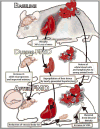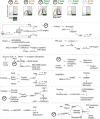Fasting, Circadian Rhythms, and Time-Restricted Feeding in Healthy Lifespan
- PMID: 27304506
- PMCID: PMC5388543
- DOI: 10.1016/j.cmet.2016.06.001
Fasting, Circadian Rhythms, and Time-Restricted Feeding in Healthy Lifespan
Abstract
Most animals alternate periods of feeding with periods of fasting often coinciding with sleep. Upon >24 hr of fasting, humans, rodents, and other mammals enter alternative metabolic phases, which rely less on glucose and more on ketone body-like carbon sources. Both intermittent and periodic fasting result in benefits ranging from the prevention to the enhanced treatment of diseases. Similarly, time-restricted feeding (TRF), in which food consumption is restricted to certain hours of the day, allows the daily fasting period to last >12 hr, thus imparting pleiotropic benefits. Understanding the mechanistic link between nutrients and the fasting benefits is leading to the identification of fasting-mimicking diets (FMDs) that achieve changes similar to those caused by fasting. Given the pleiotropic and sustained benefits of TRF and FMDs, both basic science and translational research are warranted to develop fasting-associated interventions into feasible, effective, and inexpensive treatments with the potential to improve healthspan.
Copyright © 2016 Elsevier Inc. All rights reserved.
Figures




References
-
- Asher G, Gatfield D, Stratmann M, Reinke H, Dibner C, Kreppel F, Mostoslavsky R, Alt FW, Schibler U. SIRT1 regulates circadian clock gene expression through PER2 deacetylation. Cell. 2008;134:317–328. - PubMed
-
- Barnosky AR, Hoddy KK, Unterman TG, Varady KA. Intermittent fasting vs daily calorie restriction for type 2 diabetes prevention: a review of human findings. Translational research : the journal of laboratory and clinical medicine. 2014;164:302–311. - PubMed
Publication types
MeSH terms
Substances
Grants and funding
LinkOut - more resources
Full Text Sources
Other Literature Sources
Medical

